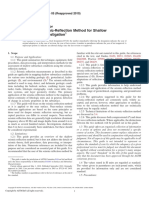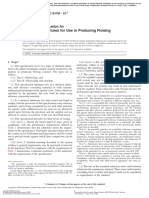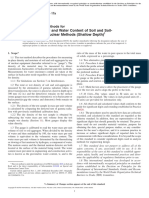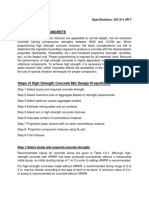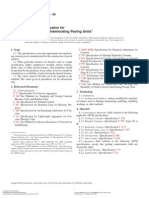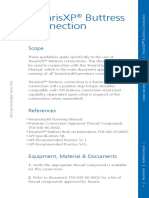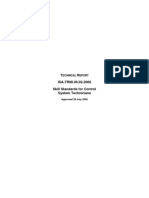Air-Entraining Admixtures For Concrete
Air-Entraining Admixtures For Concrete
Uploaded by
mickyfelixCopyright:
Available Formats
Air-Entraining Admixtures For Concrete
Air-Entraining Admixtures For Concrete
Uploaded by
mickyfelixOriginal Title
Copyright
Available Formats
Share this document
Did you find this document useful?
Is this content inappropriate?
Copyright:
Available Formats
Air-Entraining Admixtures For Concrete
Air-Entraining Admixtures For Concrete
Uploaded by
mickyfelixCopyright:
Available Formats
Designation: C260/C260M − 10a
Standard Specification for
Air-Entraining Admixtures for Concrete1
This standard is issued under the fixed designation C260/C260M; the number immediately following the designation indicates the year
of original adoption or, in the case of revision, the year of last revision. A number in parentheses indicates the year of last reapproval.
A superscript epsilon (´) indicates an editorial change since the last revision or reapproval.
1. Scope* use in the work is essentially identical in concentration,
1.1 This specification covers materials proposed for use as composition, and performance to the air-entraining admixture
air-entraining admixtures to be added to concrete mixtures in tested under this specification.
the field. NOTE 1—It is recommended that, whenever practicable, tests with the
air-entraining admixture be made using all of the ingredients of the
1.2 The values stated in either SI units or inch-pound units
concrete proposed for the specific work, because the effect produced by
are to be regarded separately as standard. The values stated in the air-entraining admixture may vary with the properties of the other
each system may not be exact equivalents; therefore, each ingredients of the concrete.
system shall be used independently of the other. Combining 4.2 Requirements for establishing compositional or chemi-
values from the two systems may result in non-conformance cal equivalence of a subsequent lot relative to a previous lot
with the standard. that was subjected to quality tests and found to comply with the
1.3 The text of this specification references notes and requirements of 5.1 shall be determined if agreed upon by the
footnotes which provide explanatory material. These notes and purchaser and the manufacturer. At the request of the
footnotes (excluding those in tables and figures) shall not be purchaser, the manufacturer shall recommend appropriate test
considered as requirements of the standard. procedures, such as infrared spectrophotometry (I.R.), pH
value and solids content, for establishing the equivalence of
2. Referenced Documents materials from different lots or different portions of the same
2.1 ASTM Standards:2 lot.
C183 Practice for Sampling and the Amount of Testing of
NOTE 2—Ultraviolet light absorption (UV) of solutions and infrared
Hydraulic Cement spectroscopy of dried residues have been found to be valuable for these
C185 Test Method for Air Content of Hydraulic Cement purposes. The specific procedures to be employed and the criteria to
Mortar establish equivalence should be stipulated with due regard to the compo-
C233 Test Method for Air-Entraining Admixtures for Con- sition and properties of the sample.
crete 4.3 At the request of the purchaser, the manufacturer shall
state in writing the chloride content of the air-entraining
3. Terminology
admixture and whether or not chloride was added during its
3.1 Definitions of Terms Specific to This Standard: manufacture.
3.1.1 air-entraining admixture, n—for the purpose of this
specification, a material that is used as an ingredient of NOTE 3—Admixtures that contain chlorides may accelerate corrosion of
embedded metals.
concrete, added to the batch immediately before or during its
mixing, for the purpose of entraining air.
5. Optional Uniformity Requirements
4. General Requirements 5.1 A series of two or more samples from a manufacturing
4.1 At the request of the purchaser, the manufacturer shall lot will be considered sufficiently uniform to be properly
state in writing that the air-entraining admixture supplied for composited into a single sample for quality testing provided
they do not differ more than the amounts indicated in 5.4.
1
This specification is under the jurisdiction of ASTM Committee C09 on 5.2 A subsequent sample or composite sample shall be
Concrete and Concrete Aggregatesand is the direct responsibility of Subcommittee considered in compliance with these requirements, so long as
C09.23 on Chemical Admixtures.
Current edition approved Dec. 15, 2010. Published January 2011. Originally they differ from the reference sample by no more than the
approved in 1950. Last previous edition approved in 2006 as C260–10. DOI: amounts listed in 5.4. The reference sample is the original
10.1520/C0260_C0260M-10a.
2
sample tested to meet the requirements of 6.1. Any additional
For referenced ASTM standards, visit the ASTM website, www.astm.org, or
optional, appropriate tests, such as infrared spectroscopy and
contact ASTM Customer Service at service@astm.org. For Annual Book of ASTM
Standards volume information, refer to the standard’s Document Summary page on ultraviolet light absorption, referred to in 4.2, also shall meet
the ASTM website. pre-agreed requirements.
*A Summary of Changes section appears at the end of this standard
Copyright © ASTM International, 100 Barr Harbor Drive, PO Box C700, West Conshohocken, PA 19428-2959. United States
Copyright by ASTM Int'l (all rights reserved); 1
C260/C260M − 10a
5.3 Determinations of uniformity shall be made in accor- test shall be not less than 80. The relative durability factor shall
dance with the procedures given in the sections “Check Tests be calculated as follows:
for Uniformity” and “Procedure for Residue by Oven Drying” DF ~ or DF1 ! 5 PN/300 (1)
of Test Method C233.
5.4 Allowable differences in results of uniformity determi- RDF 5 ~ DF/DF1 ! 3 100
nations shall not exceed the following amounts: where:
5.4.1 The manufacturer shall provide an acceptable range of DF = durability factor of the concrete containing the
pH that does not exceed 3.0 pH units. The pH of samples tested admixture under test,
shall fall within this range. DF1 = durability factor of the concrete containing the
5.4.2 The air content in percent of Test Method C185 reference admixture,
mortars prepared from successive lots shall not differ by more P = relative dynamic modulus of elasticity in percent-
than 2.0 from that for the acceptance sample. age of the dynamic modulus of elasticity at zero
5.4.3 The manufacturer shall provide acceptable limits of cycles (values of P will be 60 or greater),
residue content not to exceed 612 % of the midpoint of the N = number of cycles at which P reaches 60 %, or 300
limits. The residue content of samples tested shall fall within if P does not reach 60 % prior to the end of the test
these limits (Note 4). (300 cycles), and
NOTE 4—As an example, an admixture may commonly be produced RDF = relative durability factor.
with residue content ranging from 5.0 to 6.5 %. The manufacturer would 6.1.2 Length Change—After 14 days of drying, the length
provide acceptable limits of 5.06 to 6.44 %, representing 612 % of the
change of the concrete containing the test admixture shall not
midpoint of the limits which is 5.75 %.
be more than 120 % of that of the concrete containing the
6. Performance Requirements reference admixture. When, after 14 days of drying, the length
change of the reference concrete is less than 0.030 %, the
6.1 The air-entraining admixture shall conform to the re- length change of the concrete containing the test admixture
quirements in Table 1. shall not be more than 0.006 percentage points greater than that
6.1.1 Resistance to Freezing and Thawing—The relative of the reference concrete.
durability factor of concrete containing the admixture under
7. Sampling
7.1 Opportunity shall be provided the purchaser for careful
TABLE 1 Physical RequirementsA sampling and inspection, either at the point of manufacture or
Air-Entraining Admixtures at the site of the work, as specified by the purchaser.
Time of setting, allowable deviation from control,
h:min:
7.2 Samples shall be either “grab” or “composite” samples,
Initial: not more than 1:15 earlier as specified or required by this specification. A grab sample is
nor 1:15 later one obtained in a single operation. A composite sample is one
Final: not more than 1:15 earlier
nor 1:15 later
obtained by combining three or more grab samples.
Compressive strength, min, % of control: 7.3 For the purpose of this specification, it is recognized that
3 days 90
7 days 90 samples will be taken for the two following reasons:
28 days 90 7.3.1 Quality Tests—A sample taken for the purpose of
Flexural strength, min, % of control:B evaluating the quality of a source or lot of admixture will be
3 days 90
7 days 90 required to meet all the applicable requirements of this
28 days 90 specification. Samples used to determine conformance with the
Length change, max shrinkage
(alternative requirements):B,C
requirements of this specification shall be composites of grab
Percent of control 120 samples taken from sufficient locations to ensure that the
Increase over control, percentage pointsD 0.006 composite sample will be representative of the lot.
Relative durability factor, min 80
Bleeding of the net amount of mixing water, max
7.3.2 Uniformity Tests—A sample taken for the purpose of
percent over controlE 2 evaluating the uniformity of a single lot or of different lots
A
The values in the table include allowance for normal variation in test results. The from the same source will generally be subjected to a limited
object of the 90 % compressive strength requirement for air entraining admixtures number of tests as the result of agreement between the
is to require a level of performance comparable to that of the reference concrete. purchaser and manufacturer (see Section 4). Such samples
B
Applicable only when required by the purchaser.
C
Alternative requirements, see 6.1.2, “percent of control” limit applies when the shall be composite samples from individual lots when different
length change of the control is 0.030 % or greater, “increase over control” limit lots from the same source are being compared. When the
applies when the length change of the control is less than 0.030 %.
D
Applicable when shrinkage of control concrete is less than 0.030 %.
uniformity of a single lot is being determined, grab samples
E
Bleeding is computed as a percentage of the net amount of mixing water in each shall be used.
concrete. The net mixing water is the water in excess of that present as absorbed
water in the aggregates. For example, a test concrete mixture that contains 4.65 7.4 Liquid Air-Entraining Admixtures—Liquid admixtures
kg of net mix water and produces 0.29 kg of bleed water would have 6.24 % bleed shall be agitated thoroughly immediately prior to sampling.
water by mass of net mixing water. If a control mixture produces 7.05 % bleed Grab samples taken for quality or uniformity tests shall
water, the change in bleeding between the test and control concrete mixtures
would be − 0.81 percentage points. represent not more than 9500 L [2500 gal] of admixture and
shall have a volume of at least 1 L [1 qt]. A minimum of three
Copyright by ASTM Int'l (all rights reserved); 2
C260/C260M − 10a
grab samples shall be taken. Composite samples shall be whenever practicable, tests be made in accordance with the
prepared by thoroughly mixing the grab samples selected and section on Materials for Tests for Specific Uses in Test Method
the resultant mixture sampled to provide at least 4 L [1 gal] for C233, using the cement proposed for the specific work.
quality tests. Grab samples shall be taken from different
locations well distributed throughout the quantity to be repre- 9. Rejection
sented.
7.4.1 Admixtures in bulk storage tanks shall be sampled 9.1 The air-entraining admixture shall be rejected if the
equally from the upper, intermediate, and lower levels by purchaser desires when it fails to meet any of the applicable
means of drain cocks in the sides of the tanks or a weighted requirements of this specification.
sampling bottle fitted with a stopper that can be removed after 9.2 After completion of tests, an admixture stored at the
the bottle is lowered to the desired depth. point of manufacture for more than 6 months prior to shipment,
7.4.2 Samples shall be packaged in impermeable, airtight or an admixture in local storage in the hands of a seller for
containers that are resistant to attack by the admixture. more than 6 months, shall be retested before use when
7.5 Nonliquid Air-Entraining Admixtures—Grab samples requested by the purchaser. It shall be rejected, if the purchaser
taken for quality or uniformity tests shall represent not more desires, when it fails to conform to any of the applicable
than 2 Mg [2 tons] of admixture and shall have a mass of at requirements of this specification.
least 1 kg [2 lb]. A minimum of four grab samples shall be 9.3 Packages or containers varying more than 5 % from the
taken. Composite samples shall be prepared by thoroughly specified weight or volume shall be rejected if the purchaser
mixing the grab samples selected and the resultant mixture desires. If the average weight or volume of 50 packages or
sampled to provide at least 2.5 kg [5 lb] for the composite containers taken at random is less than that specified, the entire
sample. Grab samples shall be taken from different locations shipment shall be rejected if the purchaser desires.
well distributed throughout the quantity to be represented.
7.5.1 Samples of packaged admixtures shall be obtained by
10. Packaging and Marking
means of a tube sampler as described in Practice C183.
7.5.2 Samples shall be packaged in moisture-proof, airtight 10.1 The proprietary name of the air-entraining admixture
containers. and the net quantity in pounds or gallons (kilograms or litres)
7.6 Samples shall be thoroughly mixed before testing to shall be plainly indicated on the packages or containers in
assure uniformity. When recommended by the manufacturer, which the admixture is delivered. Similar information shall be
the entire sample of a nonliquid admixture shall be dissolved in provided in the shipping advices accompanying packaged or
water prior to testing. bulk shipments of admixtures.
8. Test Methods 11. Keywords
8.1 Determine the properties enumerated in Section 6 in 11.1 air content; air entraining admixtures; cement; con-
accordance with Test Method C233. It is recommended that, crete; pH, residue; specific gravity
SUMMARY OF CHANGES
Committee C09 has identified the location of selected changes to this specification since the last issue,
C260–10, that may impact the use of this specification. (Approved December 15, 2010)
(1) Revised the standard as a dual units specification.
Committee C09 has identified the location of selected changes to this specification since the last issue,
C260–06, that may impact the use of this specification. (Approved December 1, 2010)
(1) Revised 5.2.
Copyright by ASTM Int'l (all rights reserved); 3
C260/C260M − 10a
ASTM International takes no position respecting the validity of any patent rights asserted in connection with any item mentioned
in this standard. Users of this standard are expressly advised that determination of the validity of any such patent rights, and the risk
of infringement of such rights, are entirely their own responsibility.
This standard is subject to revision at any time by the responsible technical committee and must be reviewed every five years and
if not revised, either reapproved or withdrawn. Your comments are invited either for revision of this standard or for additional standards
and should be addressed to ASTM International Headquarters. Your comments will receive careful consideration at a meeting of the
responsible technical committee, which you may attend. If you feel that your comments have not received a fair hearing you should
make your views known to the ASTM Committee on Standards, at the address shown below.
This standard is copyrighted by ASTM International, 100 Barr Harbor Drive, PO Box C700, West Conshohocken, PA 19428-2959,
United States. Individual reprints (single or multiple copies) of this standard may be obtained by contacting ASTM at the above
address or at 610-832-9585 (phone), 610-832-9555 (fax), or service@astm.org (e-mail); or through the ASTM website
(www.astm.org). Permission rights to photocopy the standard may also be secured from the ASTM website (www.astm.org/
COPYRIGHT/).
Copyright by ASTM Int'l (all rights reserved); 4
You might also like
- Plumbing Specs SampleDocument7 pagesPlumbing Specs SampleRichmond SyNo ratings yet
- Abrasion Resistance of Horizontal Concrete Surfaces: Standard Test Method ForDocument7 pagesAbrasion Resistance of Horizontal Concrete Surfaces: Standard Test Method FormickyfelixNo ratings yet
- Concrete Made by Volumetric Batching and Continuous Mixing: Standard Specification ForDocument9 pagesConcrete Made by Volumetric Batching and Continuous Mixing: Standard Specification Formickyfelix100% (2)
- Astm E329 Pdqv6897Document8 pagesAstm E329 Pdqv6897Nayth Andres GalazNo ratings yet
- Using The Seismic-Reflection Method For Shallow Subsurface InvestigationDocument26 pagesUsing The Seismic-Reflection Method For Shallow Subsurface InvestigationmickyfelixNo ratings yet
- Estimating The Permanganate Natural Oxidant Demand of Soil and Aquifer SolidsDocument5 pagesEstimating The Permanganate Natural Oxidant Demand of Soil and Aquifer SolidsmickyfelixNo ratings yet
- As 2550.6-1995 Cranes - Safe Use Guided Storing and Retrieving AppliancesDocument8 pagesAs 2550.6-1995 Cranes - Safe Use Guided Storing and Retrieving AppliancesSAI Global - APAC100% (1)
- Astm E11Document9 pagesAstm E11Ivan AlanizNo ratings yet
- Chemical Admixtures For ConcreteDocument15 pagesChemical Admixtures For ConcreteKMNo ratings yet
- ASTM C1017-13 Standard Specification For Chemical Admixtures For Use in Producing Flowing ConcreteDocument9 pagesASTM C1017-13 Standard Specification For Chemical Admixtures For Use in Producing Flowing Concretebenedick barquinNo ratings yet
- ASTM C331-2010 Light Weight Aggregates For MasonryDocument4 pagesASTM C331-2010 Light Weight Aggregates For MasonryHaniAminNo ratings yet
- Organic Impurities in Fine Aggregates For Concrete: Standard Test Method ForDocument2 pagesOrganic Impurities in Fine Aggregates For Concrete: Standard Test Method ForMohamed KhalilNo ratings yet
- Evaluation of Cement Mortars by Ultrasound N.Gözde Özerkan, Đ. Özgür YamanDocument11 pagesEvaluation of Cement Mortars by Ultrasound N.Gözde Özerkan, Đ. Özgür YamanAdam PapworthNo ratings yet
- Astm D546Document2 pagesAstm D546Mohamed Maamoun T.No ratings yet
- Astm C109Document6 pagesAstm C109nicol pomaNo ratings yet
- Astm C131-20Document2 pagesAstm C131-20jaheshfarhadNo ratings yet
- 226 PDFDocument8 pages226 PDFBatepola BacNo ratings yet
- Astm C145 85Document2 pagesAstm C145 85Jorge Patazca100% (1)
- Is549 Evaluation of Alkali Silica Reactivity (Asr) Mortar Bar Testing (Astm c1260 and c1567) at 14 Days and 28 DaysDocument4 pagesIs549 Evaluation of Alkali Silica Reactivity (Asr) Mortar Bar Testing (Astm c1260 and c1567) at 14 Days and 28 DaysSandro Mendes100% (1)
- Plastic (Stucco) Cement: Standard Specification ForDocument4 pagesPlastic (Stucco) Cement: Standard Specification ForAlejandroNo ratings yet
- Astm C116-15 PDFDocument7 pagesAstm C116-15 PDFDanny LiangNo ratings yet
- Final Report Siliceous Byproducts For Use in Concrete 1988Document12 pagesFinal Report Siliceous Byproducts For Use in Concrete 1988engenharia.skf100% (1)
- Coarse Aggregate For Bituminous Paving MixturesDocument2 pagesCoarse Aggregate For Bituminous Paving MixturesSudharsanNo ratings yet
- Concrete and Concrete Aggregates: Standard Terminology Relating ToDocument8 pagesConcrete and Concrete Aggregates: Standard Terminology Relating TomickyfelixNo ratings yet
- Astm C33Document11 pagesAstm C33Ali ArsalanNo ratings yet
- ASTM C494/C494M-19e1 Standard Specification For Chemical Admixtures For ConcreteDocument3 pagesASTM C494/C494M-19e1 Standard Specification For Chemical Admixtures For ConcreteSudhanNo ratings yet
- Aashto M323-13Document12 pagesAashto M323-13JUAN RAMIREZNo ratings yet
- ASTM C94 Mixed ConcreteDocument13 pagesASTM C94 Mixed ConcreteZega ChrisNo ratings yet
- M 195-06 Lightweight Aggregates PDFDocument6 pagesM 195-06 Lightweight Aggregates PDFWalticoZegarraHerreraNo ratings yet
- ACI Mix DesignDocument6 pagesACI Mix DesignB BoysNo ratings yet
- Aggregate For Masonry MortarDocument2 pagesAggregate For Masonry MortarNada Khlif100% (1)
- Astm C 566 - 97Document4 pagesAstm C 566 - 97Febriana PutriyaniNo ratings yet
- C 138Document4 pagesC 138Kevin Castillo IbarraNo ratings yet
- Astm D6938 NuclearDocument3 pagesAstm D6938 NuclearRey Rapay100% (1)
- AASHTO R60-12 (2020) - Sampling Freshly Mixed ConcreteDocument5 pagesAASHTO R60-12 (2020) - Sampling Freshly Mixed ConcreteErnesto Oscar VidelaNo ratings yet
- High-Strength Concrete: Specifications: ACI 211.4R-7Document7 pagesHigh-Strength Concrete: Specifications: ACI 211.4R-7Manazir Hussain Ansari100% (1)
- Silica Fume Used in Cementitious Mixtures: Standard Specification ForDocument7 pagesSilica Fume Used in Cementitious Mixtures: Standard Specification ForRahish RaviNo ratings yet
- Astm C1293.35962Document7 pagesAstm C1293.35962margarethsmNo ratings yet
- Aashto T 119M-T 119-2013Document7 pagesAashto T 119M-T 119-2013MilonNo ratings yet
- D2172D2172M 17Document10 pagesD2172D2172M 17mehdiNo ratings yet
- Astm C128-22Document6 pagesAstm C128-22Jimmy Johan Tapia VásquezNo ratings yet
- ASTM-C1314-07 (2007) - Compressive Strength of Masonry PrismsDocument10 pagesASTM-C1314-07 (2007) - Compressive Strength of Masonry PrismsMohammad Raihan MukhlisNo ratings yet
- Flexural Strength of Concrete (Using Simple Beam With Third-Point Loading)Document5 pagesFlexural Strength of Concrete (Using Simple Beam With Third-Point Loading)madan.aliNo ratings yet
- ASTM C125-21aDocument9 pagesASTM C125-21aJimmy Johan Tapia VásquezNo ratings yet
- Compression Testing ASTM C 39 PDFDocument7 pagesCompression Testing ASTM C 39 PDFMoshiur RahmanNo ratings yet
- Astm C 936Document3 pagesAstm C 936vidhisukhadiya100% (1)
- Steel Welded Wire Reinforcement, Plain, For ConcreteDocument6 pagesSteel Welded Wire Reinforcement, Plain, For ConcreteChristian LeobreraNo ratings yet
- C652 PDFDocument7 pagesC652 PDFjadal khanNo ratings yet
- Aashto M17-07Document3 pagesAashto M17-07mohamed samirNo ratings yet
- Astm C-295Document9 pagesAstm C-295Amy100% (1)
- AASHTO T 309M-T 309-05 ASTM C 1064-C 1064M-04 Temperature of Freshly Mixed Hydraulic-Cement Concrete-FinalDocument2 pagesAASHTO T 309M-T 309-05 ASTM C 1064-C 1064M-04 Temperature of Freshly Mixed Hydraulic-Cement Concrete-Finalclint silNo ratings yet
- Astm A706 A706m 22Document4 pagesAstm A706 A706m 22alvaradolu85No ratings yet
- RILEM 20 Recommended Test Method AAR-0 PDFDocument8 pagesRILEM 20 Recommended Test Method AAR-0 PDFJorge Guerra LópezNo ratings yet
- Aashto T22Document7 pagesAashto T22AshokNo ratings yet
- Length Change of Concrete Due To Alkali-Carbonate Rock ReactionDocument4 pagesLength Change of Concrete Due To Alkali-Carbonate Rock ReactionAntu IsabelNo ratings yet
- Density, Absorption, and Voids in Hardened Concrete: Standard Test Method ForDocument3 pagesDensity, Absorption, and Voids in Hardened Concrete: Standard Test Method ForMohamed BelmokaddemNo ratings yet
- Astm C140 - 12Document16 pagesAstm C140 - 12jjaavenido100% (11)
- Bulk Density ("Unit Weight") and Voids in Aggregate: Standard Test Method ForDocument5 pagesBulk Density ("Unit Weight") and Voids in Aggregate: Standard Test Method Forاحمد علي احمدNo ratings yet
- AASHTODocument6 pagesAASHTOAngelica Fontamillas SuicoNo ratings yet
- Ha HD25-94Document20 pagesHa HD25-94John HollandNo ratings yet
- ASTM A513 Standard Specification For Electric-Resistance-Welded Carbon and Alloy Steel Mechanical TubingDocument17 pagesASTM A513 Standard Specification For Electric-Resistance-Welded Carbon and Alloy Steel Mechanical TubingSteve JonesNo ratings yet
- Bs 5400 Part 7Document24 pagesBs 5400 Part 7Ivy PaulNo ratings yet
- ASTM D412 Test Method For Vulcanized RubberDocument13 pagesASTM D412 Test Method For Vulcanized RubberElaine HuangNo ratings yet
- Concrete Aggregates: Standard Specification ForDocument11 pagesConcrete Aggregates: Standard Specification ForHarold MantillaNo ratings yet
- Amount of Water Required For Normal Consistency of Hydraulic Cement PasteDocument3 pagesAmount of Water Required For Normal Consistency of Hydraulic Cement PasteThurain Aung KyawNo ratings yet
- Air-Entraining Admixtures For ConcreteDocument4 pagesAir-Entraining Admixtures For Concretemameniq100% (2)
- Astm C 260-10Document4 pagesAstm C 260-10jun floresNo ratings yet
- Developing Appropriate Statistical Approaches For Groundwater Detection Monitoring ProgramsDocument15 pagesDeveloping Appropriate Statistical Approaches For Groundwater Detection Monitoring ProgramsmickyfelixNo ratings yet
- Latex Agents For Bonding Fresh To Hardened ConcreteDocument2 pagesLatex Agents For Bonding Fresh To Hardened ConcretemickyfelixNo ratings yet
- Chemical Admixtures For Use in Producing Flowing ConcreteDocument9 pagesChemical Admixtures For Use in Producing Flowing Concretemickyfelix100% (1)
- In-Place Density of Unhardened and Hardened Concrete, Including Roller Compacted Concrete, by Nuclear MethodsDocument5 pagesIn-Place Density of Unhardened and Hardened Concrete, Including Roller Compacted Concrete, by Nuclear MethodsmickyfelixNo ratings yet
- Fiber-Reinforced Concrete: Standard Specification ForDocument7 pagesFiber-Reinforced Concrete: Standard Specification FormickyfelixNo ratings yet
- Determining Density of Structural Lightweight Concrete: Standard Test Method ForDocument4 pagesDetermining Density of Structural Lightweight Concrete: Standard Test Method FormickyfelixNo ratings yet
- Coal Fly Ash and Raw or Calcined Natural Pozzolan For Use in ConcreteDocument5 pagesCoal Fly Ash and Raw or Calcined Natural Pozzolan For Use in ConcretemickyfelixNo ratings yet
- Total Evaporable Moisture Content of Aggregate by Drying: Standard Test Method ForDocument3 pagesTotal Evaporable Moisture Content of Aggregate by Drying: Standard Test Method FormickyfelixNo ratings yet
- Lightweight Aggregates For Structural ConcreteDocument4 pagesLightweight Aggregates For Structural ConcretemickyfelixNo ratings yet
- Splitting Tensile Strength of Cylindrical Concrete SpecimensDocument5 pagesSplitting Tensile Strength of Cylindrical Concrete SpecimensmickyfelixNo ratings yet
- Lightweight Aggregates For Concrete Masonry UnitsDocument4 pagesLightweight Aggregates For Concrete Masonry UnitsmickyfelixNo ratings yet
- Packaged, Dry, Combined Materials For Concrete and High Strength MortarDocument5 pagesPackaged, Dry, Combined Materials For Concrete and High Strength MortarmickyfelixNo ratings yet
- Lightweight Aggregates For Insulating ConcreteDocument3 pagesLightweight Aggregates For Insulating ConcretemickyfelixNo ratings yet
- Consolidated Drained Triaxial Compression Test For SoilsDocument11 pagesConsolidated Drained Triaxial Compression Test For SoilsmickyfelixNo ratings yet
- Sampling and Testing Fly Ash or Natural Pozzolans For Use in Portland-Cement ConcreteDocument10 pagesSampling and Testing Fly Ash or Natural Pozzolans For Use in Portland-Cement ConcretemickyfelixNo ratings yet
- Determination of Temporary Ditch Check Performance in Protecting Earthen Channels From Stormwater-Induced ErosionDocument8 pagesDetermination of Temporary Ditch Check Performance in Protecting Earthen Channels From Stormwater-Induced ErosionmickyfelixNo ratings yet
- Measuring Deflections Using A Portable Impulse Plate Load Test DeviceDocument5 pagesMeasuring Deflections Using A Portable Impulse Plate Load Test Devicemickyfelix100% (1)
- Field Pneumatic Slug (Instantaneous Change in Head) Tests To Determine Hydraulic Properties of Aquifers With Direct Push Groundwater SamplersDocument15 pagesField Pneumatic Slug (Instantaneous Change in Head) Tests To Determine Hydraulic Properties of Aquifers With Direct Push Groundwater SamplersmickyfelixNo ratings yet
- Highway Traffic Monitoring Truth-in-Data: Standard Practice ForDocument5 pagesHighway Traffic Monitoring Truth-in-Data: Standard Practice FormickyfelixNo ratings yet
- Preformed Polychloroprene Elastomeric Joint Seals For BridgesDocument4 pagesPreformed Polychloroprene Elastomeric Joint Seals For BridgesmickyfelixNo ratings yet
- Astm C 215Document7 pagesAstm C 215mickyfelixNo ratings yet
- Practical Guide To Street Works PDFDocument90 pagesPractical Guide To Street Works PDFarnielayne100% (1)
- H1F734 Professionalism and Ethics in ComputingDocument14 pagesH1F734 Professionalism and Ethics in ComputingFazly JabbarNo ratings yet
- Y19 Coeu CfihosDocument15 pagesY19 Coeu Cfihosmilton100% (1)
- QGL-CE-009 Design Guidelines For Road PavementDocument10 pagesQGL-CE-009 Design Guidelines For Road PavementMedhat ElhagrasyNo ratings yet
- Manual XEC+EconomicStanDocument311 pagesManual XEC+EconomicStanDscavalcanteNo ratings yet
- QAP GeneralDocument1 pageQAP GeneralVenkatRaghavendar100% (3)
- Aurora Bearing 610 CatalogDocument84 pagesAurora Bearing 610 CatalogYatin AroraNo ratings yet
- Pb-Pafsbac-006-24 SBB #3Document19 pagesPb-Pafsbac-006-24 SBB #3Albert Conrad II LopezNo ratings yet
- WD 12 BOXN (Rehab.) 2006 (Rev 1) - With Amendment No.1Document12 pagesWD 12 BOXN (Rehab.) 2006 (Rev 1) - With Amendment No.1drg gocNo ratings yet
- ANSI - ASQ - Z1.4-2003 - (R2013) Sampling Procedures and Tables For Inspection by AttributesDocument96 pagesANSI - ASQ - Z1.4-2003 - (R2013) Sampling Procedures and Tables For Inspection by AttributesKevinpooreNo ratings yet
- Manual For WCS (Vol 2 - Annexures)Document433 pagesManual For WCS (Vol 2 - Annexures)Vaishnavi Jayakumar100% (6)
- PART3 - Quality Control Manual On Concrete WorksDocument101 pagesPART3 - Quality Control Manual On Concrete WorksKelvin NgugiNo ratings yet
- R88D-KT15F I571 - Accurax - g5 - Servomotors - Drives - With - Analogue - Pulse - Output - Users - Manual - en PDFDocument596 pagesR88D-KT15F I571 - Accurax - g5 - Servomotors - Drives - With - Analogue - Pulse - Output - Users - Manual - en PDFtinafalNo ratings yet
- Sood 1979Document10 pagesSood 1979Saif EvonyNo ratings yet
- Lighting For Roadways and Bridges PDFDocument45 pagesLighting For Roadways and Bridges PDFwafikmh4No ratings yet
- M&E-TOR (Rev - May2015)Document53 pagesM&E-TOR (Rev - May2015)Sara Ikhwan Nor SalimNo ratings yet
- Unit 4 STDocument14 pagesUnit 4 STvinayakgarNo ratings yet
- Annex K (Informative) Guide For Specification Writers: Optional Provision Typical SpecificationDocument2 pagesAnnex K (Informative) Guide For Specification Writers: Optional Provision Typical SpecificationGedalías MartínezNo ratings yet
- Outsourcing - Control Is The Key To SuccessDocument4 pagesOutsourcing - Control Is The Key To SuccessRaza Ullah ShahNo ratings yet
- TXPButtress Running GuidelinesDocument13 pagesTXPButtress Running Guidelinessmithyry2014No ratings yet
- ASTEM D955 00 - Standard Test Method of Measuring Shrinkage From Mold Dimensions of Thermoplastics PDFDocument5 pagesASTEM D955 00 - Standard Test Method of Measuring Shrinkage From Mold Dimensions of Thermoplastics PDFAndre Rodriguez Spirim100% (1)
- ISA TR98.00.02 - Skill Standards For Control System TechniciansDocument22 pagesISA TR98.00.02 - Skill Standards For Control System Techniciansjuanjovm77No ratings yet
- Stress Approach of AnalysisDocument7 pagesStress Approach of AnalysisDP SinghNo ratings yet
- Pub 177Document175 pagesPub 177Larry James BroñolaNo ratings yet
- FRAMECAD Ebook - Leading by Design (UK) 2017 PDFDocument21 pagesFRAMECAD Ebook - Leading by Design (UK) 2017 PDFVengatesh Hari100% (1)
- Port 54 - 2016 - General Requirements For Medical Devices-EnglishDocument44 pagesPort 54 - 2016 - General Requirements For Medical Devices-EnglishNelson CoelhoNo ratings yet
- Standards For 7-Day and 28-Day Strength Test Results PDFDocument2 pagesStandards For 7-Day and 28-Day Strength Test Results PDFShadin Asari ArabaniNo ratings yet




